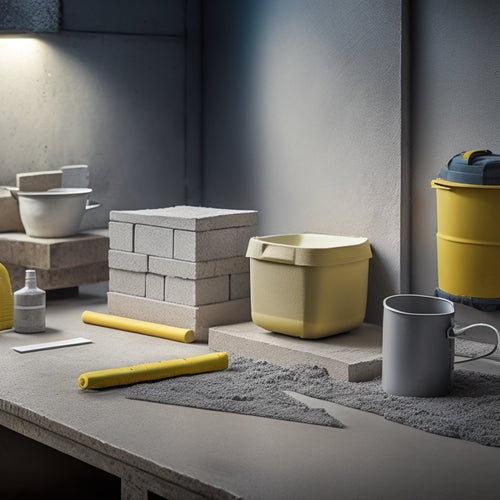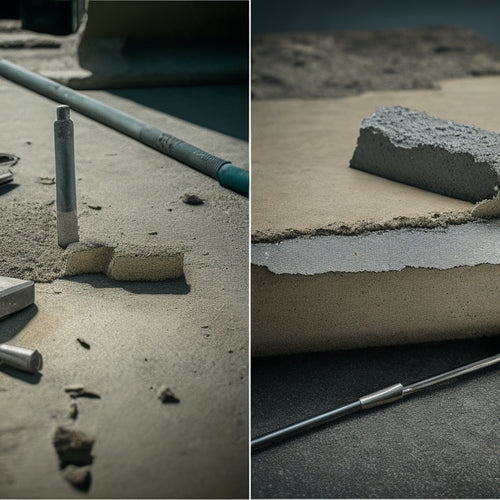
3 Best Tools for Concrete Block Waterproofing Success
Share
When it comes to concrete block waterproofing, having the right tools is vital. You'll need a roller brush with an extension pole for large surface application, a spray applicator for controlled application in smaller areas, and precision tools for sealant application. Additionally, invest in absorbent rags and solvents for cleanup, as well as a sealant-specific cleaner to guarantee effective removal without damage. By selecting these essential tools, you'll be well on your way to a successful waterproofing project. Now that you have the basics covered, it's time to explore the finer details that will take your project to the next level.
Key Takeaways
• Use a roller brush with an extension pole to efficiently apply waterproofing membranes to large concrete block surfaces.
• Invest in a spray applicator for precise control when sealing smaller areas, joints, and corners.
• Keep absorbent rags and solvents on hand to quickly clean up spills and mistakes during the application process.
• Use a scraper to remove dried sealant from tools and surfaces, and clean tools regularly to maintain their effectiveness.
• Choose a sealant-specific cleaner to ensure effective removal of excess sealant without damaging the concrete block or adjacent materials.
Essential Materials for Sealing
Select a suitable waterproofing membrane, such as a bituminous coating or an acrylic-based product, to effectively seal your concrete block structure. This membrane will serve as a barrier against water infiltration, guaranteeing the longevity of your structure.
When choosing a waterproofing membrane, consider factors such as durability, adhesion, and compatibility with the concrete block surface.
Before applying the membrane, verify proper surface preparation. Clean the surface thoroughly to remove dirt, oil, and other contaminants that may affect adhesion.
Fill any cracks or holes with a suitable filler, and allow it to dry completely. A well-prepared surface is essential for a successful seal.
Choosing the Right Sealant
With a suitable waterproofing membrane in place, you'll need to choose a compatible sealant to guarantee a watertight seal around joints, corners, and other areas where the membrane may be vulnerable to water ingress.
There are several sealant types to take into account, each with its own strengths and weaknesses. For instance, polyurethane-based sealants offer excellent flexibility and adhesion, while silicone-based sealants provide superior resistance to UV exposure and extreme temperatures.
When selecting a sealant, evaluate the specific requirements of your project, such as the type of substrate, exposure conditions, and desired level of flexibility.
It's also vital to ascertain the sealant is compatible with the waterproofing membrane and other adjacent materials.
Additionally, think about the application techniques required for each sealant type, as some may require specialized tools or equipment.
Application and Cleanup Tools
You'll need a range of specialized tools to apply your chosen sealant effectively and efficiently, as well as to clean up any excess material or spills.
For successful application, consider using roller brushes with extension poles to reach high areas or cover large surfaces quickly. These brushes come in various sizes and nap lengths to suit your specific sealant and concrete block type.
Alternatively, spray applicators can provide a more precise and controlled application, especially for smaller areas or intricate details. When working with spray applicators, make certain to use a low-pressure setting to prevent overspray and waste.
For cleanup, have a supply of absorbent rags and solvents on hand to quickly wipe up spills and remove excess sealant from tools and surfaces. A scraper or putty knife can also be useful for removing dried sealant from surfaces.
Additionally, consider investing in a sealant-specific cleaning solution to guarantee effective removal without damaging the concrete or surrounding materials.
Frequently Asked Questions
How Often Should I Reapply Sealant to Maintain Waterproofing Effectiveness?
When it comes to maintaining waterproofing effectiveness, you'll need to reapply sealant regularly.
Sealant longevity varies depending on environmental factors, so it's essential to establish a maintenance schedule. Typically, you should reapply sealant every 5 to 10 years, but this may need to be more frequent in areas with high moisture or extreme weather conditions.
Can I Use a Pressure Washer to Clean Concrete Blocks Before Sealing?
'You're probably thinking, 'Why not blast those concrete blocks clean with a pressure washer?' But, surprisingly, that's not the best approach.
In fact, using a pressure washer can damage the block's surface or dislodge dirt, making subsequent sealing a challenge.
Instead, opt for gentle pressure washer techniques and block cleaning tips like using a wide fan tip, keeping the nozzle at least 12 inches away, and avoiding high-pressure settings to guarantee a smooth, even seal.'
Are There Any Eco-Friendly or Environmentally Safe Sealant Options Available?
You're looking for eco-friendly sealant options that won't harm the environment.
Fortunately, there are biodegradable sealants available that meet your requirements. These sealants are made with natural ingredients, ensuring they're non-toxic and won't contaminate soil or water.
When selecting an eco-friendly sealant, check for certifications like EPA Safer Choice or Greenguard Gold, which guarantee the product meets rigorous environmental standards.
Will Sealing Concrete Blocks Affect Their Structural Integrity or Strength?
When you seal concrete blocks, you'll want to guarantee it doesn't compromise their structural integrity or strength.
Fortunately, most sealing techniques won't affect the concrete block properties that contribute to their load-bearing capacity.
The key is to choose a sealant that doesn't alter the block's porosity or chemical composition.
Can I Seal Concrete Blocks in Cold or Wet Weather Conditions?
You might wonder if sealing concrete blocks in cold or wet weather conditions is feasible. The theory is that temperature and humidity can affect sealant performance.
Research reveals that most sealants can't be applied in temperatures below 40°F (4°C) or when the blocks are saturated.
In reality, cold weather sealing can lead to poor adhesion, while wet weather sealing may trap moisture, causing damage.
It's best to wait for ideal conditions to guarantee a strong, durable seal.
Conclusion
You've successfully sealed your concrete blocks, ensuring a waterproof barrier that will last.
Now, consider this: did you know that water damage accounts for nearly 30% of all insurance claims? By investing in the right tools and techniques, you're saving yourself from potential financial headaches down the line.
With the right materials, sealant, and application tools, you've taken an essential step in protecting your structure from the elements.
Related Posts
-

Must-Have Handheld Tools for Concrete Repair
When tackling a concrete repair project, it is crucial to have the right handheld tools to achieve a professional fin...
-

What Tools Do I Need for Concrete Block Laying
You'll need a thorough set of tools to guarantee accurate, efficient, and professional concrete block laying. Essenti...
-

Top Tools for Concrete Adhesion Success
When it comes to concrete adhesion success, you'll need to wield the right tools and techniques to guarantee a strong...


